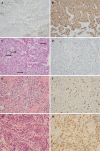Pancreatic neuroendocrine tumors G3 and pancreatic neuroendocrine carcinomas: Differences in basic biology and treatment
- PMID: 32864039
- PMCID: PMC7428799
- DOI: 10.4251/wjgo.v12.i7.705
Pancreatic neuroendocrine tumors G3 and pancreatic neuroendocrine carcinomas: Differences in basic biology and treatment
Abstract
In 2017 the World Health Organization revised the criteria for classification of pancreatic neuroendocrine neoplasms (pNENs) after a consensus conference at the International Agency for Research on Cancer. The major change in the new classification was to subclassify the original G3 group into well-differentiated pancreatic neuroendocrine tumors G3 (pNETs G3) and poorly differentiated pancreatic neuroendocrine carcinomas (pNECs), which have been gradually proven to be completely different in biological behavior and clinical manifestations in recent years. In 2019 this major change subsequently extended to NENs involving the entire digestive tract. The updated version of the pNENs grading system marks a growing awareness of these heterogeneous tumors. This review discusses the clinicopathological, genetic and therapeutic features of poorly differentiated pNECs and compare them to those of well-differentiated pNETs G3. For pNETs G3 and pNECs (due to their lower incidence), there are still many problems to be investigated. Previous studies under the new grading classification also need to be reinterpreted. This review summarizes the relevant literature from the perspective of the differences between pNETs G3 and pNECs in order to deepen understanding of these diseases and discuss future research directions.
Keywords: Clinical management; Gene sequencing; Histopathology; Neuroendocrine neoplasms; Pancreatic neuroendocrine carcinomas; Pancreatic neuroendocrine tumors G3.
©The Author(s) 2020. Published by Baishideng Publishing Group Inc. All rights reserved.
Conflict of interest statement
Conflict-of-interest statement: Authors declare no conflict of interests for this article.
Figures



Similar articles
-
Clinical relevance of different WHO grade 3 pancreatic neuroendocrine neoplasms based on morphology.Endocr Connect. 2018 Feb;7(2):355-363. doi: 10.1530/EC-17-0388. Endocr Connect. 2018. PMID: 29472376 Free PMC article.
-
World Health Organization grading classification for pancreatic neuroendocrine neoplasms: a comprehensive analysis from a large Chinese institution.BMC Cancer. 2020 Sep 22;20(1):906. doi: 10.1186/s12885-020-07356-5. BMC Cancer. 2020. PMID: 32962649 Free PMC article.
-
Prediction of Pathological Grades of Pancreatic Neuroendocrine Tumors Based on Dynamic Contrast-Enhanced Ultrasound Quantitative Analysis.Diagnostics (Basel). 2023 Jan 9;13(2):238. doi: 10.3390/diagnostics13020238. Diagnostics (Basel). 2023. PMID: 36673048 Free PMC article.
-
Pancreatic neuroendocrine tumors.Intractable Rare Dis Res. 2017 Feb;6(1):21-28. doi: 10.5582/irdr.2017.01007. Intractable Rare Dis Res. 2017. PMID: 28357177 Free PMC article. Review.
-
Update on surgical treatment of pancreatic neuroendocrine neoplasms.World J Gastroenterol. 2014 Oct 14;20(38):13893-8. doi: 10.3748/wjg.v20.i38.13893. World J Gastroenterol. 2014. PMID: 25320524 Free PMC article. Review.
Cited by
-
Pancreatic Neuroendocrine Tumors: Signaling Pathways and Epigenetic Regulation.Int J Mol Sci. 2024 Jan 22;25(2):1331. doi: 10.3390/ijms25021331. Int J Mol Sci. 2024. PMID: 38279330 Free PMC article. Review.
-
A relook at gastroenteropancreatic neuroendocrine tumours as per 2019 WHO classification-A tertiary centre experience.Ir J Med Sci. 2023 Oct;192(5):2065-2070. doi: 10.1007/s11845-022-03217-1. Epub 2022 Nov 21. Ir J Med Sci. 2023. PMID: 36409421
-
DNA methylation reveals distinct cells of origin for pancreatic neuroendocrine carcinomas and pancreatic neuroendocrine tumors.Genome Med. 2022 Mar 1;14(1):24. doi: 10.1186/s13073-022-01018-w. Genome Med. 2022. PMID: 35227293 Free PMC article.
References
-
- Fesinmeyer MD, Austin MA, Li CI, De Roos AJ, Bowen DJ. Differences in survival by histologic type of pancreatic cancer. Cancer Epidemiol Biomarkers Prev. 2005;14:1766–1773. - PubMed
-
- Ito T, Igarashi H, Nakamura K, Sasano H, Okusaka T, Takano K, Komoto I, Tanaka M, Imamura M, Jensen RT, Takayanagi R, Shimatsu A. Epidemiological trends of pancreatic and gastrointestinal neuroendocrine tumors in Japan: a nationwide survey analysis. J Gastroenterol. 2015;50:58–64. - PubMed
-
- Hallet J, Law CH, Cukier M, Saskin R, Liu N, Singh S. Exploring the rising incidence of neuroendocrine tumors: a population-based analysis of epidemiology, metastatic presentation, and outcomes. Cancer. 2015;121:589–597. - PubMed
-
- Milione M, Maisonneuve P, Spada F, Pellegrinelli A, Spaggiari P, Albarello L, Pisa E, Barberis M, Vanoli A, Buzzoni R, Pusceddu S, Concas L, Sessa F, Solcia E, Capella C, Fazio N, La Rosa S. The Clinicopathologic Heterogeneity of Grade 3 Gastroenteropancreatic Neuroendocrine Neoplasms: Morphological Differentiation and Proliferation Identify Different Prognostic Categories. Neuroendocrinology. 2017;104:85–93. - PubMed
Publication types
LinkOut - more resources
Full Text Sources
Medical

